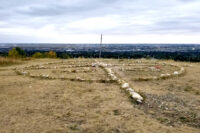City dealing with invasive fish swimming in local storm ponds
By Herald on October 28, 2021.
 Herald photo by Al Beeber -
Associated Engineering’s Dean Foster prepares netting as colleague Filip Kurbatfinski unloads equipment to help take an inventory of invasive fish at Firelight Park.
Herald photo by Al Beeber -
Associated Engineering’s Dean Foster prepares netting as colleague Filip Kurbatfinski unloads equipment to help take an inventory of invasive fish at Firelight Park.Dale Woodard – Lethbridge Herald
There’s something a little fishy going on in local storm ponds.
Aquatic invasive species, including prussian carp (goldfish) and other aquarium species, such as koi, have become an issue at Firelight Park, Chinook Lake and Elma Groves Pond.
On Wednesday afternoon, contractors armed with boats and equipment began taking an inventory of invasive species at Firelight Park to determine the type, size and quantities of fish present in the Firelight Park in order to prepare the necessary environmental permits and scope of work to address the issue.
“Over the next couple of days there will be an inventory taken of the types, sizes and quantities of invasive species that are currently in Firelight Park,” said Stephanie Vehnon, communications and outreach specialist for the Water, Waste Water and Stormwater department with the City of Lethbridge. “It’s a continuation of an assessment that was taken last summer in July of 2020. So we’re continuing in order to find out what is currently present so next spring we can continue on and remove those invasive species from this pond.
“It’s a common problem all across Alberta. Alberta Environment did studies all across the province to find out where they were a problem.”
Mitigation work is planned for summer 2022 following all Alberta Environment guidelines.
“Today and tomorrow is just an inventory,” said Vehnon. “But next spring is when they will be removed. More on that process will be shared in the spring. But they are removed from the pond and donated to Birds of Prey.”
The other two ponds will go through the same process at a later date.
Aquatic invasive species illegally released into storm water ponds and other water bodies alter aquatic habitats so it becomes uninhabitable for native populations, potentially spreading diseases to native species.
“How they get in there is they’re actually released in there,” said Vehnon, adding that can be through storm drains or being physically placed in the pond. “They are non-native species. So they compete with the native species for food and habitat and eventually out-compete them. They grow very rapidly, so it becomes a problem very quickly.”
Vehnon said thus far the non-native fish have been found in Firelight Park, Chinook Lake and Elma Groves Pond, but other local ponds are also a possibility.
“These are the three we’re starting with and Firelight Park is our first focus.”
People spotting the non-native fish are asked to contact Alberta Environment, said Vehnon.
“There is information on our invasive species website. There is a 1-800 number they can call directly and they’ll guide you on how to dispose of them appropriately.
“We definitely don’t want people releasing gold fish or any aquarian species into our storm ponds. You can take them to your pet store or call Alberta Environment to direct you for disposal.”
Vehnon said it’s illegal to dump non-native fish.
“You can be fined under the Fisheries Act for it and we really encourage community members not to do it.”
More information about aquatic invasive species in Lethbridge can be accessed at http://www.lethbridge.ca/invasivespecies.
20-19




